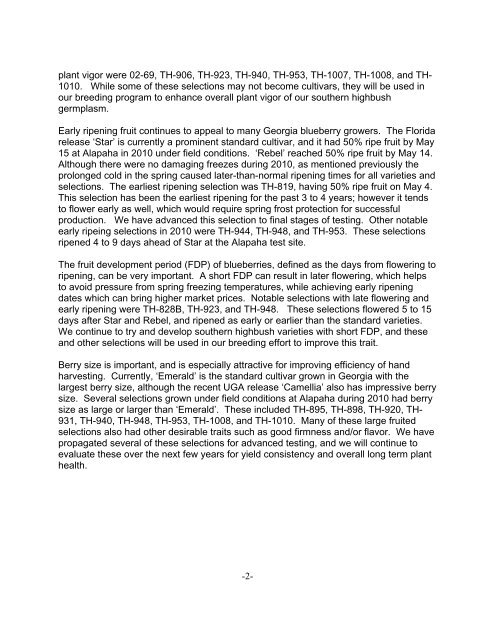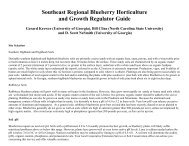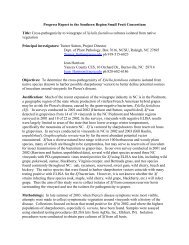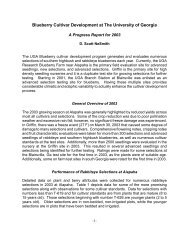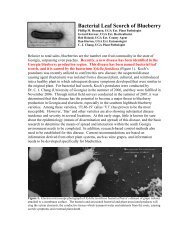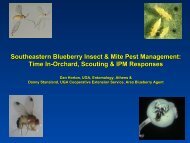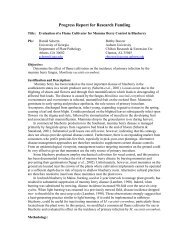Blueberry Cultivar Development at The University of Georgia
Blueberry Cultivar Development at The University of Georgia
Blueberry Cultivar Development at The University of Georgia
Create successful ePaper yourself
Turn your PDF publications into a flip-book with our unique Google optimized e-Paper software.
plant vigor were 02-69, TH-906, TH-923, TH-940, TH-953, TH-1007, TH-1008, and TH-1010. While some <strong>of</strong> these selections may not become cultivars, they will be used inour breeding program to enhance overall plant vigor <strong>of</strong> our southern highbushgermplasm.Early ripening fruit continues to appeal to many <strong>Georgia</strong> blueberry growers. <strong>The</strong> Floridarelease ‘Star’ is currently a prominent standard cultivar, and it had 50% ripe fruit by May15 <strong>at</strong> Alapaha in 2010 under field conditions. ‘Rebel’ reached 50% ripe fruit by May 14.Although there were no damaging freezes during 2010, as mentioned previously theprolonged cold in the spring caused l<strong>at</strong>er-than-normal ripening times for all varieties andselections. <strong>The</strong> earliest ripening selection was TH-819, having 50% ripe fruit on May 4.This selection has been the earliest ripening for the past 3 to 4 years; however it tendsto flower early as well, which would require spring frost protection for successfulproduction. We have advanced this selection to final stages <strong>of</strong> testing. Other notableearly ripeing selections in 2010 were TH-944, TH-948, and TH-953. <strong>The</strong>se selectionsripened 4 to 9 days ahead <strong>of</strong> Star <strong>at</strong> the Alapaha test site.<strong>The</strong> fruit development period (FDP) <strong>of</strong> blueberries, defined as the days from flowering toripening, can be very important. A short FDP can result in l<strong>at</strong>er flowering, which helpsto avoid pressure from spring freezing temper<strong>at</strong>ures, while achieving early ripeningd<strong>at</strong>es which can bring higher market prices. Notable selections with l<strong>at</strong>e flowering andearly ripening were TH-828B, TH-923, and TH-948. <strong>The</strong>se selections flowered 5 to 15days after Star and Rebel, and ripened as early or earlier than the standard varieties.We continue to try and develop southern highbush varieties with short FDP, and theseand other selections will be used in our breeding effort to improve this trait.Berry size is important, and is especially <strong>at</strong>tractive for improving efficiency <strong>of</strong> handharvesting. Currently, ‘Emerald’ is the standard cultivar grown in <strong>Georgia</strong> with thelargest berry size, although the recent UGA release ‘Camellia’ also has impressive berrysize. Several selections grown under field conditions <strong>at</strong> Alapaha during 2010 had berrysize as large or larger than ‘Emerald’. <strong>The</strong>se included TH-895, TH-898, TH-920, TH-931, TH-940, TH-948, TH-953, TH-1008, and TH-1010. Many <strong>of</strong> these large fruitedselections also had other desirable traits such as good firmness and/or flavor. We havepropag<strong>at</strong>ed several <strong>of</strong> these selections for advanced testing, and we will continue toevalu<strong>at</strong>e these over the next few years for yield consistency and overall long term planthealth.-2-


